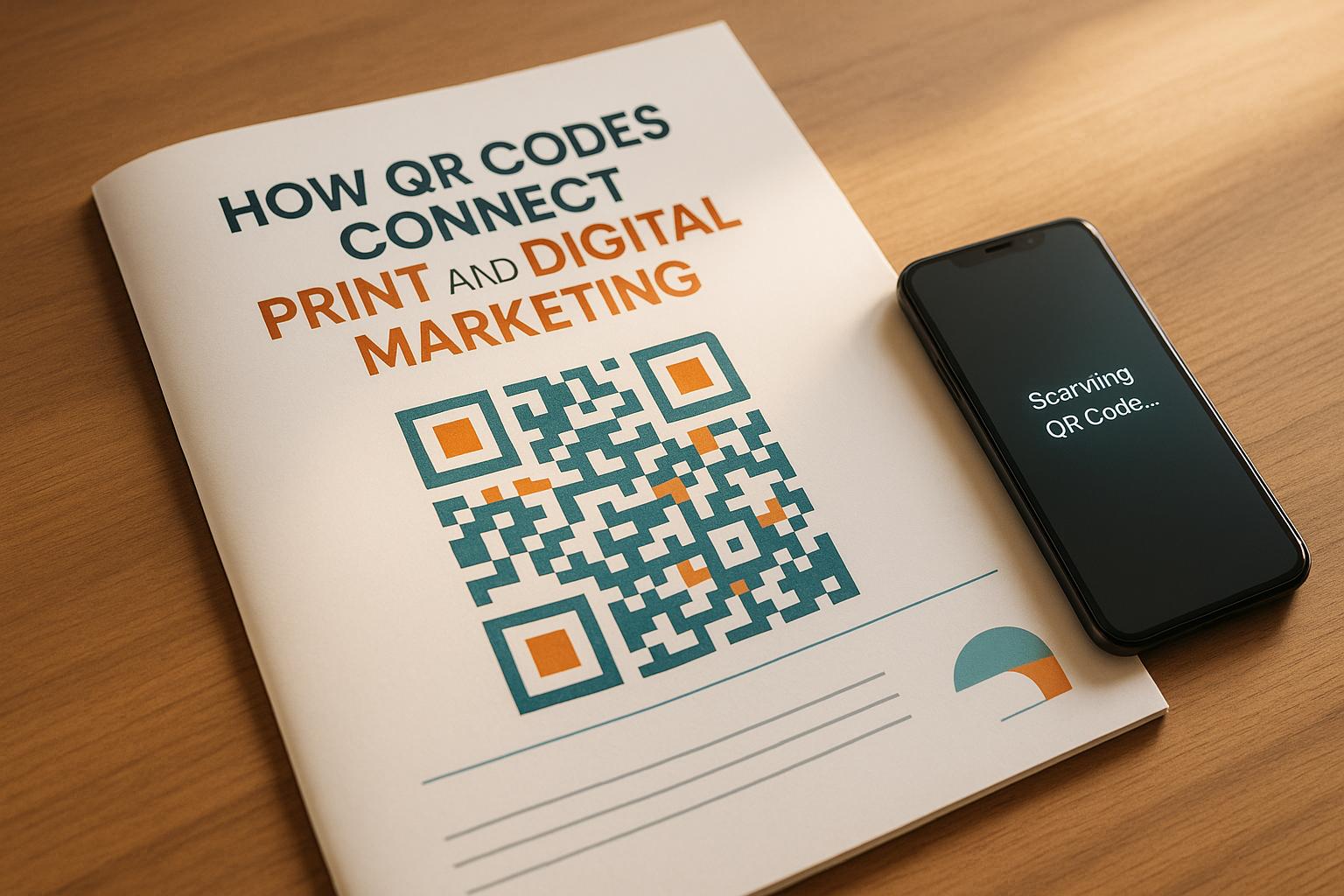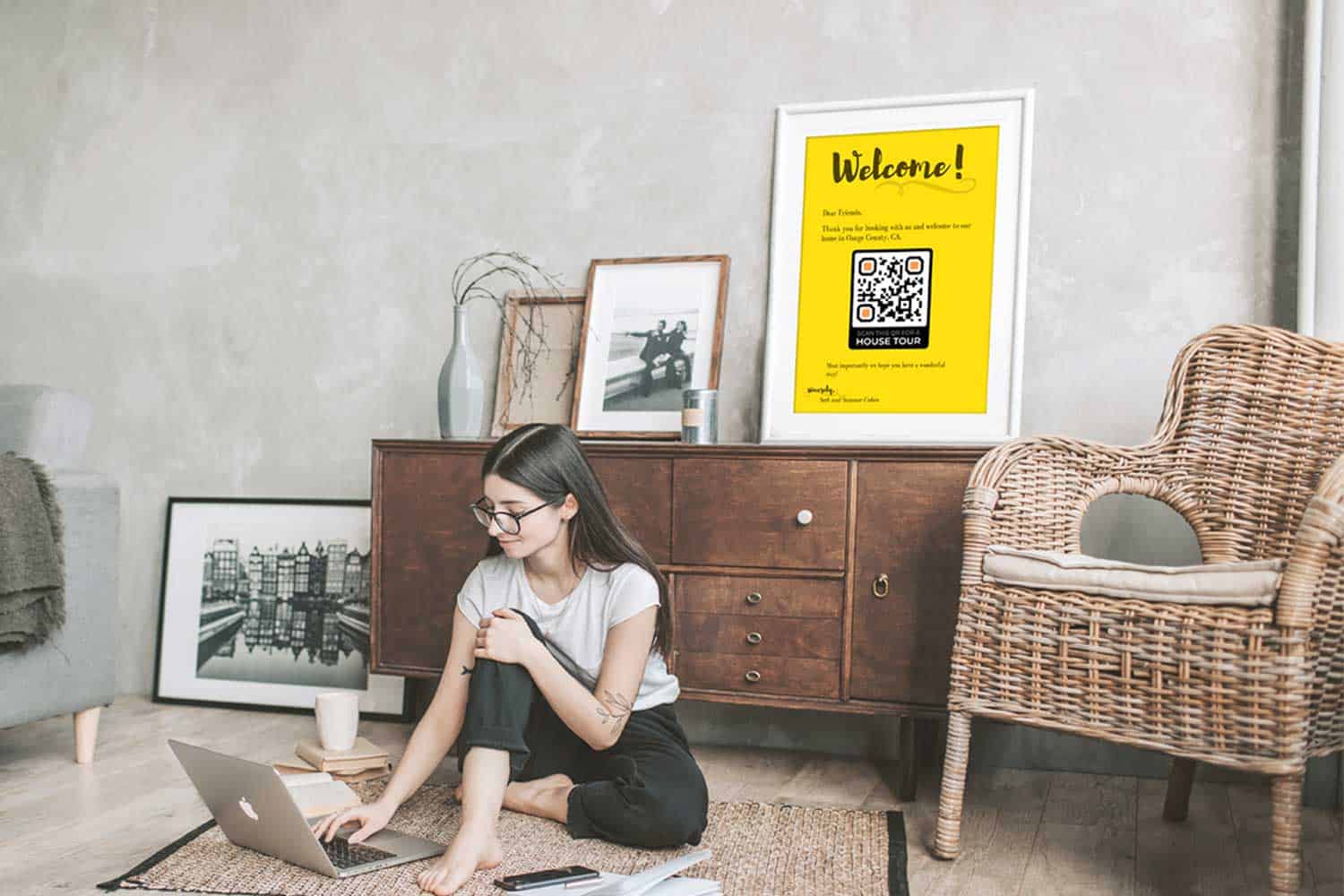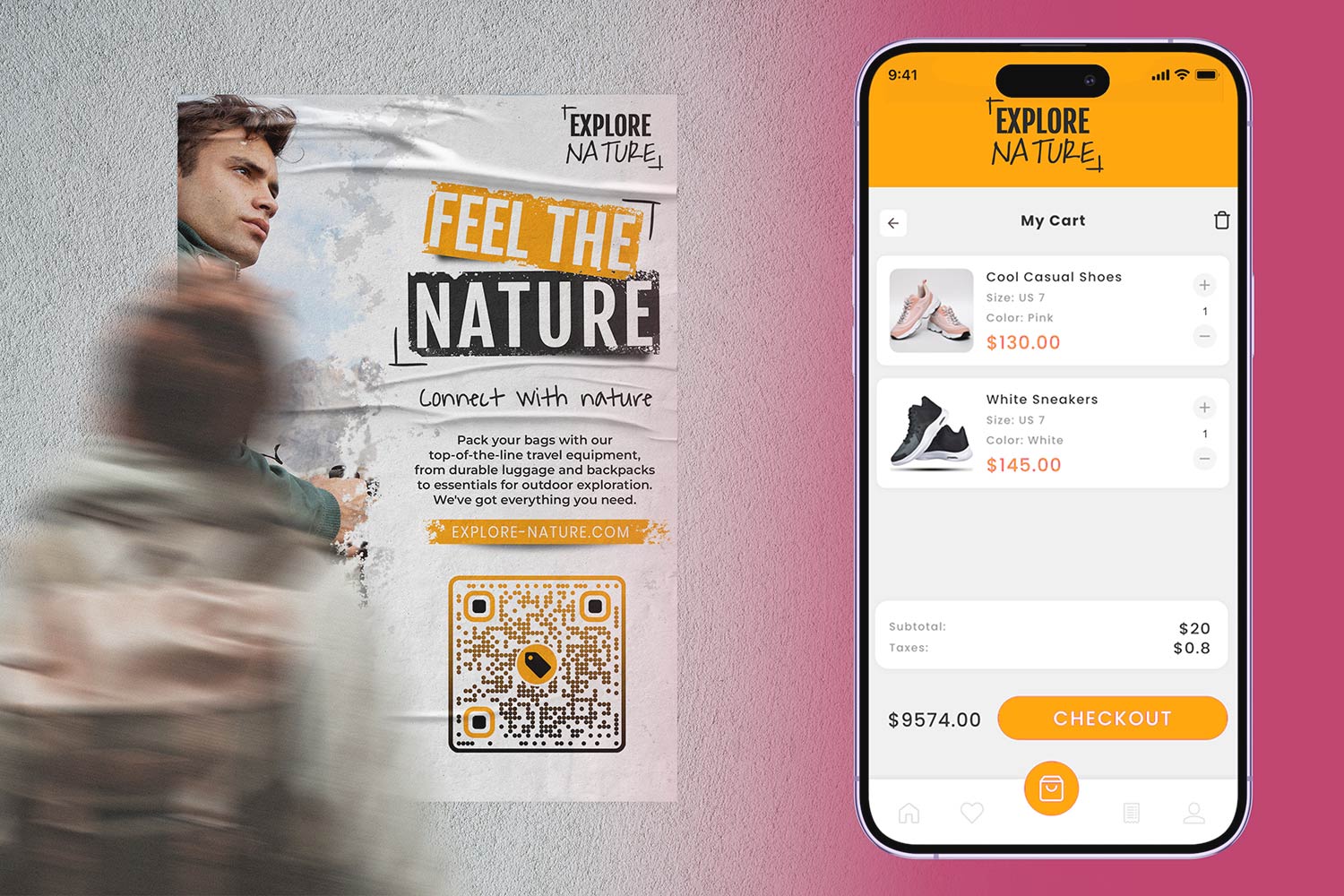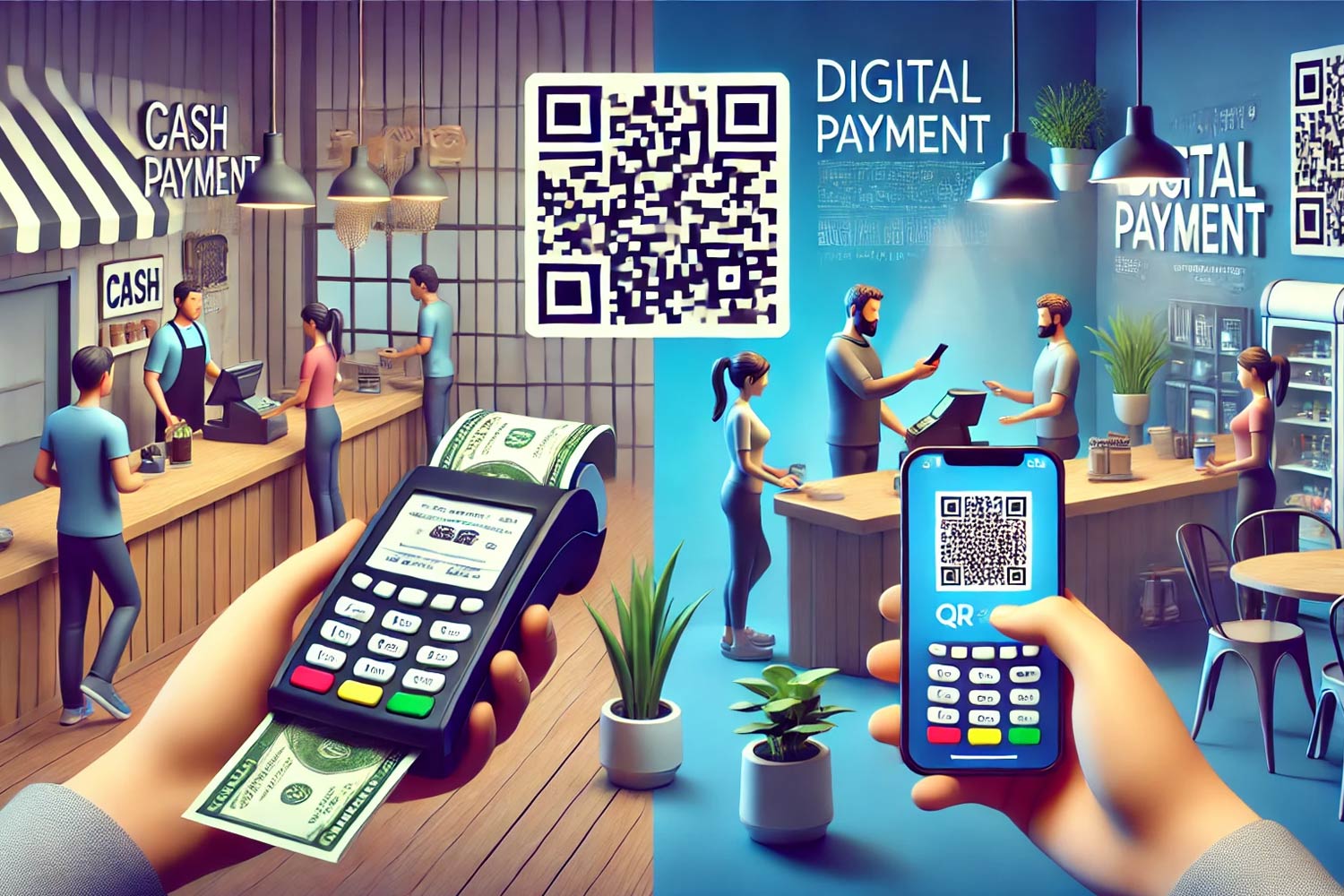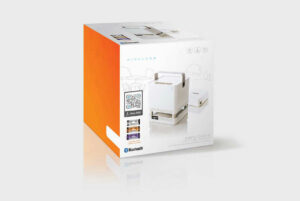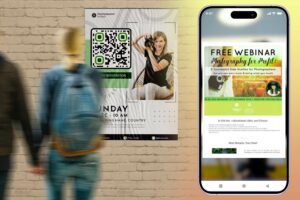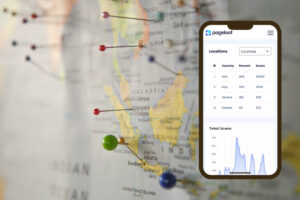QR codes are a simple way to link print materials to digital content. They turn static items like flyers, posters, or product packaging into interactive tools. With just a scan, users can access websites, videos, or special offers. Businesses use QR codes to track offline marketing, collect data, and improve engagement.
Key Takeaways:
- 84.62% of people have scanned a QR code.
- QR code campaigns see a 37% click-through rate, much higher than traditional ads.
- In 2023, QR code usage in marketing grew by 323%.
- Dynamic QR codes offer real-time analytics, making tracking and updates easier.
- Examples include L’Oréal’s product info codes and Flipkart’s 2M scans in one day.
QR codes are cost-effective, measurable, and cater to today’s demand for seamless digital experiences. Whether for promotions, payments, or customer feedback, they bridge the gap between print and digital marketing effortlessly.
How QR Codes Have Transformed Marketing
How QR Codes Connect Print and Digital Marketing
QR codes have an incredible ability to bridge the gap between traditional print materials and the digital world. By scanning a simple code on a brochure or poster, customers gain access to multimedia content, special offers, and direct interactions with brands.
Turning Print Materials into Interactive Tools
QR codes transform static print into dynamic digital tools. When added to items like flyers, posters, or product packaging, they instantly connect users to websites, videos, forms, or other online resources that wouldn’t fit within the constraints of print.
This is particularly handy for brands looking to overcome space limitations. For instance, Waterfall Glen Soap Company uses dynamic QR codes on their packaging to share evolving stories without adding clutter.
"Through QR codes, printed materials have become a more complete and engaging experience for users." – Abstrakt Marketing Group
This approach allows businesses to keep their print designs clean and professional while offering rich digital experiences. A business card can link to a full portfolio, video introductions, or interactive contact forms. Similarly, restaurant menus can connect diners to ingredient details, chef videos, or nutritional information without overcrowding the menu.
QR codes also enable two-way communication. At Phoenix’s Sky Harbor Airport, QR codes in restrooms let travelers report maintenance issues with a quick scan. This practical use shows how QR codes can turn any printed sign into an interactive tool.
These creative applications highlight the potential for QR codes to revolutionize print marketing.
Case Studies and Research Findings
Real-world examples showcase the measurable impact of QR codes in connecting print and digital. MDL Marinas Group used QR codes on printed notices, posters, and welcome packs to increase digital engagement. As pandemic restrictions eased, their welcome packs with QR codes led to 900 registrations for their new system.
"QR codes bridged the gap between traditional media and new ways of delivering information." – Tim Mayer, Sales and Marketing Director at MDL Marinas
Other industries have seen impressive results. L’Oréal incorporated QR codes into their SmartLabel™ system, giving consumers easy access to product information. This move boosted consumer engagement with their products by 7%. Even small improvements in accessibility can lead to noticeable business outcomes.
A standout example is Flipkart, which ran a print campaign in a national newspaper to promote holiday sales. By placing QR codes on the front page, they offered exclusive deals and a chance to win a free iPhone. The result? Over 2 million QR code scans within 24 hours. This campaign demonstrates how print can directly drive digital interactions.
Research also highlights the effectiveness of QR codes. 79% of marketers report better message retention when QR codes and other interactive elements are added to campaigns. The simple act of scanning makes the experience more memorable than just reading static print.
The food industry has embraced QR codes in creative ways. Back in 2012, Taco Bell used QR codes on Doritos Locos Taco packaging to link customers to exclusive videos from the Feed the Beat Concert Series. Each week, the QR code led to a new video, turning product packaging into a platform for entertainment.
Consumer Preferences for Connected Experiences
The rise of QR codes also reflects changing consumer habits. Today’s customers expect a seamless blend of physical and digital experiences. QR codes meet this demand by eliminating the hassle of typing URLs or searching for content. When you create a QR code to link print materials to digital content, you’re catering to consumers who are always connected and ready for instant access.
The shift toward contactless interactions, accelerated by the COVID-19 pandemic, has only strengthened the case for QR codes. This trend isn’t a temporary fix – it represents a lasting change in how people interact with brands and access information.
Some campaigns are pushing the boundaries of QR code usage. Tripadvisor, for example, collaborated with tourism authorities to create street art in cities like New York, Los Angeles, and Chicago. Each mural included a QR code that launched augmented reality (AR) experiences tied to San Diego. These campaigns turn public spaces into interactive marketing tools.
As QR codes integrate with technologies like AR, they create richer, more memorable experiences. These moments go beyond sharing information – they spark conversations and encourage social sharing, extending the reach of print campaigns into digital spaces. Consumers’ growing expectations make it clear: print materials need to act as gateways to engaging digital experiences.
Data-driven benefits and performance metrics
QR codes do more than just link print to digital – they provide a treasure trove of measurable insights that traditional print marketing simply can’t match. Unlike static ads, QR codes offer detailed analytics, helping marketers understand campaign performance and pinpoint areas for improvement.
Real-time analytics and offline-to-online tracking
When you use dynamic QR codes, you unlock real-time data that takes campaign tracking to another level. These codes provide metrics like total scans, unique users, scan locations (down to city and country), device operating systems, and even time-specific engagement data.
This kind of insight allows businesses to pivot quickly. For instance, a catering company discovered through QR code analytics that their ads performed better during certain months. With this knowledge, they shifted their marketing budget to focus on high-engagement periods and adjusted strategies during slower times.
Location data is especially useful for businesses operating in multiple markets. A global e-commerce retailer used QR codes on print ads across various countries to promote a new product line. The analytics revealed which regions had the highest scan rates, guiding their decisions on where to expand next.
Another example: an indie game company used QR codes at a gaming convention to determine whether potential players preferred Android or iOS. This information directly shaped their app development and marketing strategies.
By integrating QR code data with Google Analytics through UTM parameters, businesses can compare QR-driven traffic to other digital channels. This gives a clearer picture of how print-to-digital campaigns contribute to the overall marketing strategy. These insights are key to improving engagement and boosting conversions.
Improving engagement and conversion rates
QR codes consistently outperform traditional digital ads when it comes to user engagement. On average, QR code campaigns achieve a click-through rate of 12.80% – far exceeding Google display ads (5.06%), email marketing (2.60%), Facebook ads (0.90%), and Instagram feed ads (0.22%).
The adoption of QR codes has grown rapidly. In 2024, dynamic QR codes alone generated 6,825,842 scans. In the U.S., 89 million smartphone users scanned QR codes in 2022, and projections suggest that number will surpass 100 million by 2025.
Real-world campaigns highlight their effectiveness. HSBC UK partnered with Shelter to promote bank accounts for individuals without a fixed address, using QR codes. The campaign led to a 52% increase in account openings within two weeks and turned 20% of QR code users into regular donors, helping over 100 people transition off the streets.
Tourism New Brunswick used QR codes on direct mail flyers and TV ads, leading users to a contest landing page. This campaign saw a 1.77% engagement rate, with 80% of users who visited the main page continuing to the contest page.
In healthcare, PatientPoint placed QR codes in 2,300 locations, including hospitals and self-checkout stations. This campaign resulted in 270,000 scans and engaged 208,000 visitors.
| Campaign Type | Engagement Rate | Key Outcome |
|---|---|---|
| HSBC UK Banking | 20% conversion to donors | 52% increase in account openings |
| Tourism New Brunswick | 1.77% direct mail rate | 80% contest page conversion |
| PatientPoint Healthcare | 270,000 total scans | 208,000 engaged visitors |
These results show how QR codes can transform print campaigns into powerful tools for digital engagement.
Collecting audience data
Beyond tracking scans, QR codes can reveal valuable behavioral insights that help refine marketing strategies. For example, a real estate agency used QR codes on storefront displays to promote properties with unique features. By analyzing scan times, they identified peak engagement periods and adjusted display schedules to attract more potential buyers.
QR codes are also ideal for A/B testing. Marketers can experiment with different placements, designs, or calls-to-action to see what resonates most with their audience.
Take the M+ museum in Hong Kong as an example. They used dynamic, multilingual QR codes throughout the visitor journey, from onboarding to exhibit navigation. This approach helped them address visitor pain points, resulting in 148,000 scans and 113,000 engaged visitors across 42 different QR codes.
Demographic data from QR code analytics is equally insightful. Studies show that 83% of people have scanned a QR code at least once, and 42% of U.S. shoppers have used QR codes while shopping, proving that consumers are comfortable with this technology across industries.
To maximize the benefits, businesses should create QR codes with analytics capabilities and monitor the data regularly – weekly during active campaigns, and monthly for ongoing initiatives. This allows for quick adjustments and ensures campaigns stay on track. By continuously analyzing this data, marketers can fine-tune their QR code designs and strategies for better results.
sbb-itb-74874c9
Designing QR Codes for Marketing Success
Creating effective QR codes goes beyond just generating a scannable square. It requires careful design, strategic placement, and technical precision. When done right, QR codes can significantly boost engagement, strengthen your branding, and seamlessly link offline campaigns to online experiences.
Branding and Customization for Trust and Recognition
Customizing QR codes to match your brand’s identity can make a big difference. By incorporating your logo, brand colors, and design elements, you can create codes that feel like they belong to your marketing materials – not as a last-minute addition.
The impact of customization is clear: customized QR codes can increase scan rates by up to 80%. Research also shows that 76% of people consider design quality when deciding to scan, and 70% are influenced by branding. Adding your logo to the center of a QR code not only reinforces brand recognition but also builds trust. A recognizable logo reassures users that the QR code is authentic and safe to scan.
One standout example of creative QR code branding comes from Guinness in 2012. They designed beer mugs that revealed QR codes when filled with Guinness beer. Scanning these codes gave users access to exclusive promotions and allowed them to update their social media statuses.
If you’re looking to create a branded QR code, tools like Pageloot let you customize elements like the eyes, colors, patterns, and frames. The goal is to balance aesthetics with functionality – your QR code should look appealing while remaining easy to scan across various devices and lighting conditions.
Dynamic QR Codes for Versatility
Dynamic QR codes take things a step further by giving you the flexibility to update content, track performance, and adjust strategies without reprinting materials. Unlike static codes, which are locked into a single destination, dynamic codes adapt to evolving needs.
Marriott Aruba saw the value of dynamic QR codes during the COVID-19 pandemic. By replacing printed menus with QR codes, they saved approximately $150,000 in printing costs. Similarly, Lionsgate used dynamic QR codes to run targeted and localized campaigns for film promotions, achieving over 12,000 engagements across 65 cities.
Dynamic codes also enable advanced features like A/B testing, personalization, and redirection based on location or language preferences. This adaptability makes them a powerful tool for creating tailored user experiences.
"Marketing teams that implement QR codes – especially if they use newer, dynamic QR code technology – gain significant competitive advantages in customer engagement, data collection, and revenue generation, transforming every consumer touchpoint into an opportunity for meaningful connection." – Sharat Potharaju, Co-Founder and CEO at Uniqode
Optimizing QR Codes for Print Materials
The technical design of QR codes plays a major role in their scannability. Factors like size, contrast, placement, and material quality all contribute to how well your codes perform in the real world.
Size is crucial. The minimum recommended size for printed QR codes is 0.8 x 0.8 inches (2 x 2 cm). However, size should increase with viewing distance. For every 4 inches of distance, add an extra 0.4 inches to the code’s dimensions. This ensures users can scan comfortably without straining.
Contrast is key. For best results, use dark QR codes on light backgrounds. Avoid gradients or complex backgrounds that could interfere with readability. Smartphone cameras need clear distinctions between the code and its surroundings to scan effectively.
Coca-Cola’s SmartLabel campaign highlights the importance of proper QR code optimization. By placing QR codes on over 2,000 products in the U.S., they provided detailed ingredient and nutritional information. Impressively, 99% of their SmartLabel traffic came from mobile scans, demonstrating how well-optimized QR codes drive engagement.
The New York Times also used QR codes effectively in a 2020 campaign. Partnering with Facebook, they included QR codes in their Sunday edition to unlock AR filters related to California wildfires and women’s suffrage. Proper sizing and placement were vital to the campaign’s success.
| Print Material | Minimum Size | Key Considerations |
|---|---|---|
| Business Cards | 0.8 x 0.8 inches | High contrast, avoid fold lines |
| Flyers | 1.0 x 1.0 inches | Eye-level placement, clear call-to-action |
| Posters | 1.5 x 1.5 inches | Larger size for distance viewing |
| Product Labels | 0.8 x 0.8 inches | Smooth, non-reflective material |
Material quality matters. Smooth, non-reflective surfaces work best for indoor use, while weather-resistant materials are ideal for outdoor applications, such as on vehicles or windows.
Placement affects usability. Aim to position QR codes at eye level and ensure they’re free from clutter. Avoid placing them in corners or on folds where they might get damaged. Users typically need at least 15 seconds to scan a QR code, so make sure the placement allows for easy and comfortable scanning.
Always include a clear call-to-action, such as “Scan for Menu” or “Get Exclusive Offers,” to encourage engagement. And don’t forget to test your QR codes across multiple devices and lighting conditions before mass printing. High-resolution images or vector formats like SVG, EPS, or PDF are essential to avoid pixelation when scaling.
Advanced QR Code Applications and Strategies
QR codes have grown far beyond their original use for sharing information. Today, they’re powerful marketing tools that not only encourage engagement but also help businesses gather valuable customer insights.
Trending Use Cases in Marketing
QR code usage is on the rise, with 93% of marketers reporting increased use over the past year and 88% noting improved consumer attitudes toward the technology.
One major driver of this growth is contactless payments. For instance, PayPay gained 15 million new users in just 10 months through QR code sign-ups. Another example is event check-ins – Vincle saw a 90% increase in attendance by using QR codes instead of traditional methods.
Personalized promotions are another standout application. About 51% of marketers use QR codes for time-sensitive offers, while 39% of consumers scan them to access exclusive content, followed by 33% who do so for discounts.
Marketers are also integrating QR codes across multiple channels, including:
- Email campaigns (47%)
- Product packaging (46%)
- Events (43%)
- Print advertisements (40%)
This multi-channel approach creates seamless connections between physical and digital experiences. Looking ahead, 57% of marketers plan to integrate QR codes with augmented reality (AR), while 84% are exploring artificial intelligence (AI) to deliver personalized recommendations.
A great example of a creative QR code campaign comes from Burger King. In 2021, they aired a TV ad featuring a QR code that offered viewers a free Whopper, blending traditional media with instant digital interaction. Such examples underscore the importance of dependable tools for managing QR code strategies, like Pageloot.
Using Platforms Like Pageloot

Platforms like Pageloot offer solutions that make it easier for marketers to maximize the potential of QR codes. Trusted by over 20,000 companies across 110 countries, Pageloot helps small and medium businesses overcome common challenges in QR code implementation.
One key feature is editable QR codes, which solve the problem of static print materials. For instance, Hugo Laurent, a restaurant owner, used Pageloot to digitize his menu by uploading a PDF. He described it as the "most easy and reliable QR code generator ever".
Pageloot also provides real-time analytics, offering insights such as scan counts, locations, device types, and peak engagement times. This data helps businesses refine their strategies for better results.
Customization options allow users to build trust with branded QR codes featuring custom logos, colors, and designs. Lucas Jansen, a real estate developer, used Pageloot’s location QR code feature to showcase property listings and praised the platform for its many useful features.
Security is another strength, with options like time-based access restrictions, password protection, and secure hosting. These features are particularly useful for industries like healthcare or for safeguarding sensitive business information.
Pageloot supports a variety of QR code types, including:
- PDF QR codes for product manuals
- vCard QR codes for contact sharing
Emma Moretti, a retail manager, created vCard QR codes for her employees, making it simple for customers to save their contact details. Additionally, the platform provides print-ready files in formats like EPS, PDF, and SVG, ensuring high-resolution QR codes for materials such as business cards and flyers.
Static vs. Dynamic QR Codes
Choosing between static and dynamic QR codes depends on your campaign’s goals, budget, and flexibility needs. Here’s how they compare:
| Feature | Static QR Codes | Dynamic QR Codes |
|---|---|---|
| Editability | Fixed; cannot be changed | Can be updated anytime via a dashboard |
| Analytics | No tracking | Detailed scan data (location, device, etc.) |
| Cost | Usually free | Free trial, then paid plans |
| Campaign Flexibility | One-time use | Ideal for ongoing, adaptive campaigns |
| Data Storage | Embedded directly in the code | Uses short URLs for cleaner designs |
| Security Features | Basic protection | Advanced options like password protection |
| A/B Testing | Not supported | Fully supported |
| Retargeting | Not supported | Supported via integrations |
Static QR codes are best for permanent information like Wi-Fi passwords or basic contact details. Dynamic QR codes, on the other hand, excel in flexible marketing campaigns that require tracking and optimization – think seasonal menus, limited-time promotions, or campaigns needing performance measurement.
Dynamic codes also use short URLs, which make them cleaner and easier to scan, regardless of the content’s complexity. For businesses juggling multiple campaigns, these codes offer advanced features like device-specific content delivery, geographic targeting, and time-based redirects. With eight QR codes generated every minute worldwide and U.S. usage expected to surpass 100 million users next year, selecting the right type of QR code is more important than ever.
For more details, check out the dynamic vs. static QR code comparison. While static codes are great for straightforward needs, dynamic codes unlock the tools required for data-driven marketing success.
Conclusion
QR codes are reshaping the way print and digital marketing work together. With 59% of consumers scanning QR codes daily and QR-driven campaigns achieving an impressive 37% click-through rate, it’s clear they play a pivotal role in enhancing customer engagement.
As discussed earlier, businesses can use these insights to fine-tune their marketing efforts. QR codes create a seamless connection between physical materials and digital platforms, offering measurable results and valuable data. For instance, 95% of businesses report that QR codes help them collect first-party data, while 79% use dynamic QR codes to deliver personalized, context-specific experiences. This ability to gather data transforms printed materials from static displays into effective tools for generating leads.
In today’s marketing landscape, QR codes address real challenges by providing instant access to digital content, enabling precise tracking, and offering cost-efficient solutions for businesses of any size. Their versatility is evident in a wide range of uses, from restaurant menus to business cards, each offering unique ways to connect with customers.
"People use them to uplift their response rate… It just makes it easier for customers to find your product and follow up on the call to action." – Carly Brown, Click2Mail’s Customer Support Manager
Looking ahead, the potential of QR codes is set to grow even further with advancements like AI-driven personalization, augmented reality features, and voice-activated interactions. These innovations promise to strengthen the integration of print and digital marketing, making QR codes an even more essential tool for businesses.
Whether you’re using a free QR generator for simple campaigns or advanced dynamic codes for detailed tracking, QR codes offer solutions tailored to diverse marketing goals. They’ve become a critical component in bridging traditional advertising with modern strategies, helping businesses of all sizes connect with their audiences in meaningful ways.
FAQs
How can businesses measure the success of their QR code campaigns?
Businesses have a variety of tools at their disposal to gauge the success of their QR code campaigns. One powerful method is using real-time analytics to track important metrics such as scan rates, user locations, and the types of devices being used. Platforms like Pageloot simplify this process by providing detailed insights into how users interact with QR codes and how campaigns perform overall.
Another smart tactic is incorporating UTM parameters into QR code URLs. These parameters allow businesses to monitor user behavior and conversion rates through tools like Google Analytics. By combining these analytics tools with tracking methods, businesses can make informed decisions to fine-tune their QR code marketing efforts and achieve better outcomes.
How can you use QR codes creatively in print materials to boost engagement?
QR codes can turn static print materials into interactive tools, offering a fresh way to capture your audience’s attention. Imagine embedding QR codes into flyers, posters, or brochures that lead to exclusive discounts, videos, or your website. Or placing them on product packaging, event tickets, or business cards, giving users instant access to product details, event schedules, or your contact information.
For a stronger impact, consider customizing your QR codes with your logo and brand colors to make them instantly recognizable. Dynamic QR codes take it a step further by letting you update the linked content without needing to reprint anything – a practical way to stay flexible. Plus, tracking their performance through analytics can provide valuable insights to refine your campaigns. Thoughtfully integrating QR codes helps connect the dots between print and digital, creating a smoother and more engaging experience for your customers.
What’s the difference between dynamic and static QR codes, and which one is better for your business?
Dynamic and static QR codes are designed to meet different needs depending on your business goals. Static QR codes are set in stone once created, making them a great fit for straightforward uses like printed menus or flyers. Since they can’t be edited, they’re best for situations where the information won’t change.
On the flip side, dynamic QR codes are much more versatile. You can edit their content or destination URL anytime without needing to print a new code. They also come with advanced features like real-time updates, detailed scan analytics, and even retargeting options. This makes them perfect for businesses running longer campaigns that require tracking and adjustments over time.
For instance, if you’re managing a marketing campaign and want to measure performance or tweak content, dynamic QR codes are the way to go. But if you just need to share static, unchanging details, static QR codes are a cost-effective option. The choice boils down to whether you need adaptability and analytics or a simple, no-frills solution.

